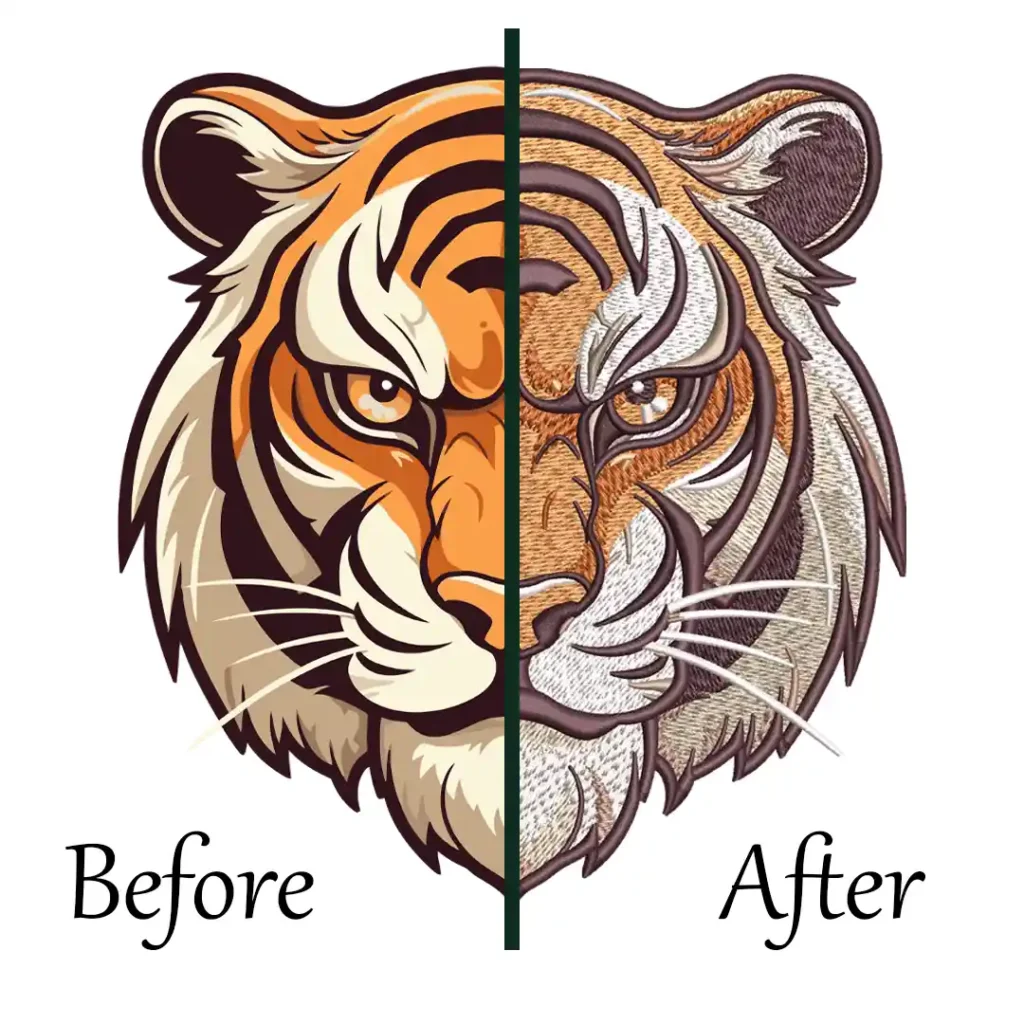Have you ever finished an embroidery project, only to find ugly hoop marks ruining your beautiful work? Don’t worry—you’re not alone! Learning how to avoid and fix hoop burn in machine embroidery can save your fabric and elevate your embroidery game. Hoop burn isn’t just frustrating; it can make even the best designs look unprofessional. But here’s the good news: it’s completely preventable and fixable!
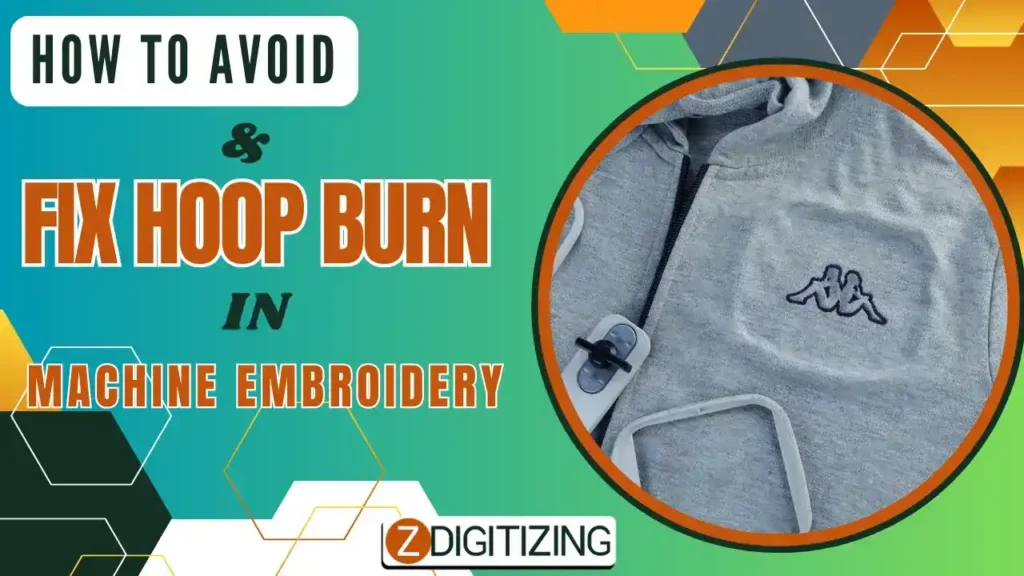
With a few smart techniques and the right tools, you can avoid those stubborn marks altogether or easily fix them if they appear. So, keep reading—you won’t want to miss these life-saving embroidery tips!
How to Avoid and Fix Hoop Burn in Machine Embroidery
What is Hoop Burn in Machine Embroidery?
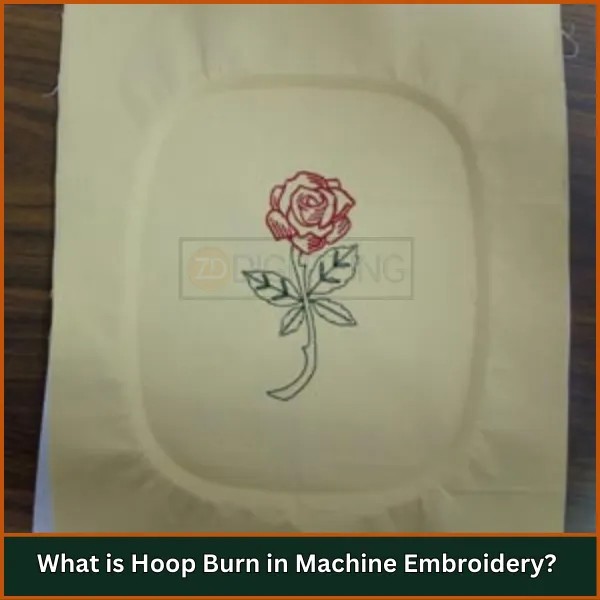
Hoop burn happens when an embroidery hoop leaves marks or dents on fabric after being tightly secured. These marks often look shiny or pressed down, following the shape of the hoop. It usually happens because the hoop squeezes the fabric fibers too much, causing them to flatten or stretch. Hoop burn is especially common on delicate fabrics or materials with a pile, like velvet or fleece, and can be hard to remove. This can affect the look of your embroidery and make your project less professional.
What Are the Causes of Hoop Burn?
Hoop burn occurs due to various factors that affect how the fabric reacts to being secured in the hoop. Understanding these causes can help prevent this common issue:
- Excessive hoop tension
- Extended hooping time
- Incorrect hooping technique
- Inappropriate hoop size
- Fabric characteristics
- Heat and moisture
1. Excessive Hoop Tension
Over-tightening the embroidery hoop can compress the fabric fibers too much, leading to shiny, burned areas where the hoop contacts the fabric. This is particularly problematic with delicate materials that are sensitive to pressure.
2. Extended Hooping Time
Leaving fabric hooped for prolonged periods can cause it to retain the shape of the hoop, resulting in permanent marks or distortions. This is especially true for fabrics that are prone to stretching or damage.
3. Incorrect Hooping Technique
Improperly hooped fabric may shift during embroidery, causing uneven tension and increasing the risk of hoop burn. Ensuring that the fabric is taut but not overly tight is crucial for preventing this issue.
4. Inappropriate Hoop Size
Using a hoop that is too small for the design can lead to excessive tension on the fabric, while a hoop that is too large may not hold the fabric securely enough, causing movement and potential burn.
5. Fabric Characteristics
Different fabrics react differently to embroidery processes. Materials like knits or those with a pile (like velvet) are more susceptible to hoop burn compared to sturdier fabrics like canvas or denim.
6. Heat and Moisture
The combination of heat generated by the embroidery machine and moisture from humidity or steam can exacerbate the risk of hoop burn, especially if combined with tight hooping.
Embroidery Digitizing & Vector Art Services
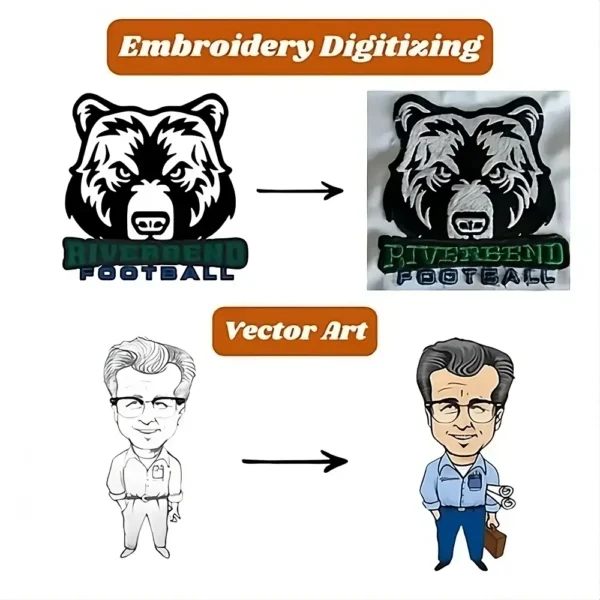
Looking for embroidery digitizing and vector art services that are affordable and reliable? We offer fast turnaround time, guaranteed quality, and the option to preview your design before payment, we make sure you get exactly what you need. Your satisfaction is our top priority, and we’re dedicated to delivering the best results. Don’t wait—try ZDigitizing today and see the difference in quality and service!
Embroidery Digitizing & Vector Art Services
Looking for embroidery digitizing and vector art services that are affordable and reliable? We offer fast turnaround time, guaranteed quality, and the option to preview your design before payment, we make sure you get exactly what you need. Your satisfaction is our top priority, and we’re dedicated to delivering the best results. Don’t wait—try ZDigitizing today and see the difference in quality and service!
Best Practices to Avoid Hoop Burn in Machine Embroidery
To prevent hoop burn in embroidery, you need to pay close attention to your embroidery process and the tools you use. Following these preventative measures can help protect your fabric:
- Proper Hooping Techniques
- Using the Right Stabilizers
- Adjusting Machine Settings
- Floating Technique
- Masking Fabric
- Utilizing Magnetic Hoops
- Regularly Testing Stabilizers and Fabrics
1. Proper Hooping Techniques
Make sure the fabric is hooped correctly. Use the Finger Test to check for any wrinkles or bumps after hooping. The Clock Method can help tighten the hoop evenly all around, so the fabric stays secure without too much pressure.
2. Using the Right Stabilizers
Pick the right stabilizer for your fabric. Light fabrics work well with tear-away stabilizers, while thicker fabrics need cut-away stabilizers. For tricky fabrics, use adhesive or water-soluble stabilizers to avoid extra pressure on the fabric.
3. Adjusting Machine Settings
Set your embroidery machine properly. Adjust thread tension, sewing speed, needle type, and stitch density to match the fabric. Lower speeds and correct needle sizes help avoid fabric damage and hoop burn.
4. Floating Technique
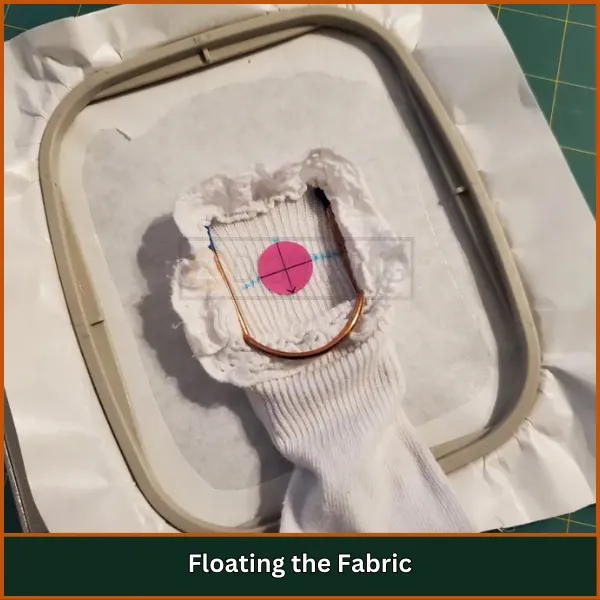
Instead of hooping the fabric, only hoop the stabilizer. Place the fabric on top of it and secure it with pins or temporary glue. This method avoids direct hoop pressure on the fabric and helps prevent marks.
5. Masking Fabric
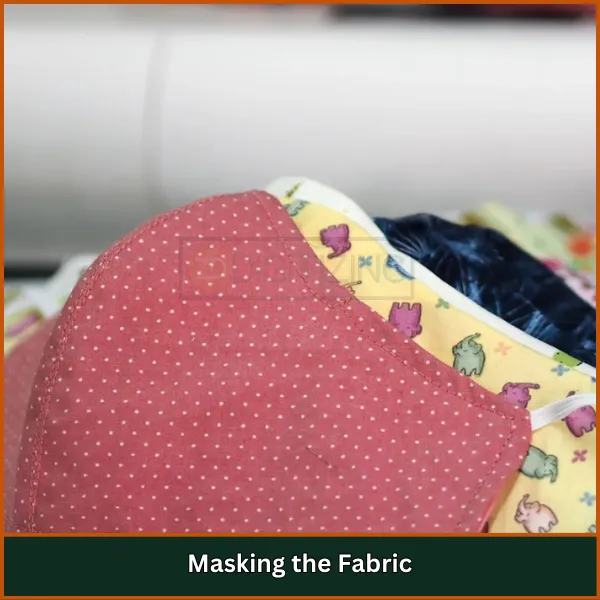
For delicate materials like leather or silk, place a layer of another fabric between the hoop and the main fabric. This cushion spreads out the hoop’s pressure and protects the fabric from marks or burns.
6. Utilizing Magnetic Hoops
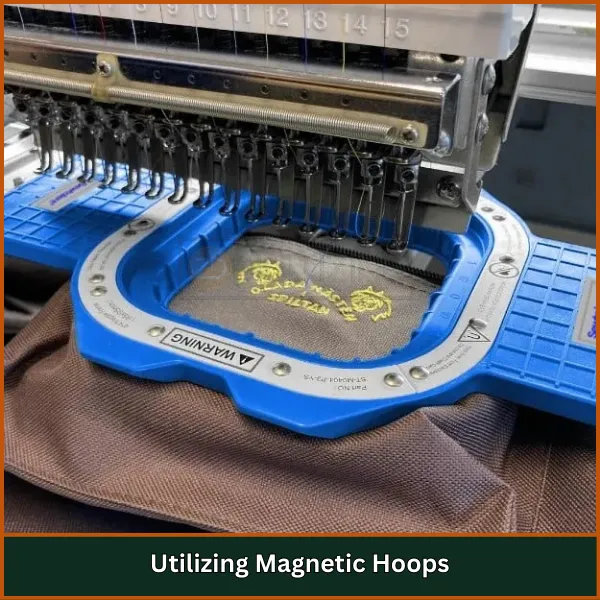
Magnetic hoops hold the fabric firmly without squeezing it too much. They keep the tension even and are easy to remove, which helps reduce the chances of hoop burn.
7. Regularly Testing Stabilizers and Fabrics
Try out different stabilizers and fabrics before starting a big project. Testing lets you see what works best and prevents problems like hoop burn from ruining your embroidery.
How to Fix Existing Hoop Burns in Machine Embroidery
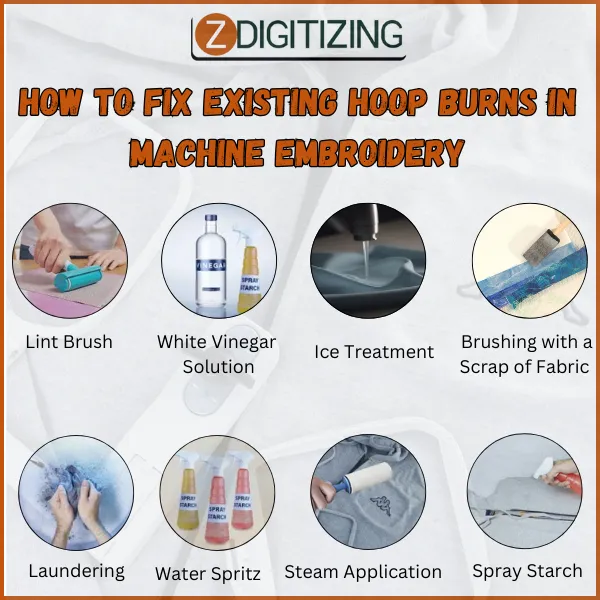
If fixing hoop burn on fabric is necessary, there are several simple methods to remove or reduce it. Try the following techniques:
- Laundering
- Water Spritz
- Steam Application
- Spray Starch
- Lint Brush
- White Vinegar Solution
- Ice Treatment
- Brushing with a Scrap of Fabric
1. Laundering
Washing the fabric is one of the easiest ways to fix hoop burn. A gentle wash can fluff up the compressed fibers and remove the marks. Be sure to follow the fabric’s care instructions to prevent damage.
2. Water Spritz
Spray a light mist of water on the affected area using a spray bottle. Gently pat the fabric to relax the fibers, then let it air dry. This helps restore the fabric’s natural texture.
3. Steam Application
Use steam from an iron or a handheld steamer to treat the marks. Keep the fabric about six inches away from the steam and move it evenly over the area. Lay the fabric flat to dry afterward to allow the fibers to recover.
4. Spray Starch
Spray a small amount of starch on the affected area, then gently wipe it with a clean cloth. This helps lift and restore flattened fibers, improving the fabric’s appearance.
5. Lint Brush
Roll a lint brush or adhesive tape over the hoop burn area. This method gently lifts and separates the compressed fibers, making it effective for minor marks.
6. White Vinegar Solution
Mix a small amount of white vinegar with water and spray it on the affected area. The vinegar helps refresh the fibers and acts as a gentle cleaning agent to restore the fabric.
7. Ice Treatment
Rub an ice cube gently over the hoop burn. As the ice melts, it hydrates and relaxes the fibers. Massage the area lightly with your fingers and let it air dry to restore the fabric’s texture.
8. Brushing with a Scrap of Fabric
Use a piece of scrap fabric to rub over the hoop burn area. This creates gentle friction that lifts and separates the fibers, helping restore the original look without causing further damage.
Special Techniques to Avoid Hoop Burns for Sensitive Fabrics
When correcting hoop burn on delicate fabrics, it’s important to use gentle methods that minimize pressure and protect the material. Here are some effective techniques:
- Use a Masking Fabric: Place a thin layer of similar fabric or lightweight cotton over the sensitive material to act as a buffer, reducing direct contact with the hoop.
- Utilize Fast Frames: Fast frames provide a quick and secure setup without creating excessive tension, making them ideal for minimizing hoop burn.
- Select Appropriate Stabilizers: Opt for soft, lightweight stabilizers that give adequate support without compressing or damaging the fabric.
- Hoop with Care: Gently hoop the fabric, ensuring even tension and avoiding overtightening to prevent compression marks.
- Consider Magnetic Hoops: Magnetic hoops hold the fabric securely without squeezing it too tightly, making them an excellent choice for delicate fabrics.
Embroidery Digitizing & Vector Art Services

Looking for embroidery digitizing and vector art services that are affordable and reliable? We offer fast turnaround time, guaranteed quality, and the option to preview your design before payment, we make sure you get exactly what you need. Your satisfaction is our top priority, and we’re dedicated to delivering the best results. Don’t wait—try ZDigitizing today and see the difference in quality and service!
Embroidery Digitizing & Vector Art Services
Looking for embroidery digitizing and vector art services that are affordable and reliable? We offer fast turnaround time, guaranteed quality, and the option to preview your design before payment, we make sure you get exactly what you need. Your satisfaction is our top priority, and we’re dedicated to delivering the best results. Don’t wait—try ZDigitizing today and see the difference in quality and service!
Conclusion
Hoop burn can be frustrating, but with the right steps, you can avoid and fix hoop burn in machine embroidery and keep your projects looking flawless. Simple techniques like adjusting hoop tension, using the right stabilizers, and trying magnetic hoops can save your fabric from marks and help your embroidery shine.
If you want to take your embroidery projects to the next level, ZDigitizing is here to help! We provide professional digitizing services with guaranteed quality, super-fast turnaround time, and a preview option so you know exactly what you’ll get. Plus, if it’s your first order, we’ll give you an exclusive 50% discount!
Don’t let hoop burn or poor-quality designs hold you back. Choose ZDigitizing for the best digitizing services at the most affordable rates. Contact us now and see how we can make your embroidery truly stand out!
FAQs
You can prevent hoop burn by using the right stabilizers, loosening hoop tension, and placing a protective layer like a masking fabric between the hoop and the fabric. Magnetic hoops are also a great option for delicate fabrics.
Wrap your embroidery hoop with soft fabric or bias tape to create a cushion. This helps reduce direct pressure on the fabric and prevents marks caused by the hoop edges.
No, hoop burn is not permanent in most cases. It can usually be fixed with methods like steaming, brushing, or washing the fabric to restore its original texture.
Yes, wrapping your hoop with fabric or tape is a good idea. It not only protects the fabric from hoop burn but also gives a better grip, making it easier to work with.
Use techniques like the floating method, where you only hoop the stabilizer and lay the fabric on top, or choose magnetic hoops to reduce direct pressure on the fabric. Adjusting tension and using the right stabilizer also helps.

